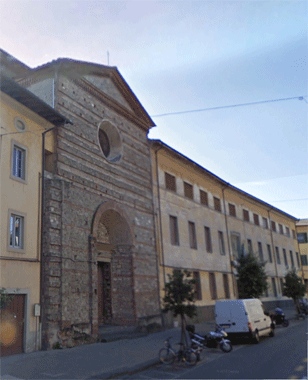The large reinassance church of Saint Giovanni Battista with its adjacent conservatory was one of the most famous buildings that was damaged by the bombing of Pistoia in 1943 during the second world war. In 1950, the building was reconstructed "a rustico" (roughly) inside its supporting structure, leaving the original decorative stone fragments dismantled, which today are still preserved inside. 
The church was part of an ancient monastery founded in 1321 on the request of Giovanni Ammannati who had given permission for the building of the monastery in his will in 1287. He requested that it be built inside his own building and that it would become a monastery of the nuns of the 'Ordine di San Francesco e Santa Chiara, le clarisse (Order of Saint Francesco and Saint Chiara, the Clarisse) and named after San Giovanni Battista (Saint Giovanni Battista).
The importance of this order in Pistoia grew over time, to the point that in 1469 the Abbess, Sister Lisa Baldovinetti from Florence, decided to restore the entire building. For these works, she employed the architect Ventura Vitoni from Pistoia. Work began on the monastry, where the new layout of the space was given over to a clear reinassance design, inspired by the architectural patterns found in the Florentine convents of the period.
On the 13th of April 1500 the first stone of the Church of Saint Giovanni Battista was placed. The building, with a latin cross layout, was characterised by a wide apse and an imposing central dome, which can probably be considered as the most mature work by Vitoni. The architectural themes, which had already been experimented with in other works in the town such as the church of Saint Chiara, near to Via Puccini, and Santa Maria delle Grazie (Saint Mary of Graces), close to the Ceppo hospital are found here fully formed and developed. As has been documented in various guides to Pistoia and in some photographs from the past, the church of Saint Giovanni Battista was full of prestigious works of art: big marble altars, liturgical furniture, and a series of sixteen canvases with 'Le storie di San Giovanni Battista' (The stories of Saint Giovanni Battista) which had been done by painters from Florence and Pistoia during the 17th century. Unfortunately, this collection was completely destroyed during the bombing raids of the second world war.
In 1783 the Bishop of Pistoia, Scipione de' Ricci, combined the monastry of Saint Giovanni Battista with those of Saint Chiara and Saint Lucia. Two years later Pietro Leopoldo d'Asburgo Lorena, Grand duke of Tuscany, forced the nuns of Pistoia to choose between rigid convent life and renouncing all their possesions and the possibility of giving life to the 'Conservatori' (Conservatories) which were designed for the education of young girls. The nuns of Saint Giovanni Battista chose this second option, taking charge of the instruction of young girls until 1883, when the conservatory was declared as an 'Istituto pubblico educativo' (Public Educational Institute) and became dependent on the Italian government.

The church was part of an ancient monastery founded in 1321 on the request of Giovanni Ammannati who had given permission for the building of the monastery in his will in 1287. He requested that it be built inside his own building and that it would become a monastery of the nuns of the 'Ordine di San Francesco e Santa Chiara, le clarisse (Order of Saint Francesco and Saint Chiara, the Clarisse) and named after San Giovanni Battista (Saint Giovanni Battista).
The importance of this order in Pistoia grew over time, to the point that in 1469 the Abbess, Sister Lisa Baldovinetti from Florence, decided to restore the entire building. For these works, she employed the architect Ventura Vitoni from Pistoia. Work began on the monastry, where the new layout of the space was given over to a clear reinassance design, inspired by the architectural patterns found in the Florentine convents of the period.
On the 13th of April 1500 the first stone of the Church of Saint Giovanni Battista was placed. The building, with a latin cross layout, was characterised by a wide apse and an imposing central dome, which can probably be considered as the most mature work by Vitoni. The architectural themes, which had already been experimented with in other works in the town such as the church of Saint Chiara, near to Via Puccini, and Santa Maria delle Grazie (Saint Mary of Graces), close to the Ceppo hospital are found here fully formed and developed. As has been documented in various guides to Pistoia and in some photographs from the past, the church of Saint Giovanni Battista was full of prestigious works of art: big marble altars, liturgical furniture, and a series of sixteen canvases with 'Le storie di San Giovanni Battista' (The stories of Saint Giovanni Battista) which had been done by painters from Florence and Pistoia during the 17th century. Unfortunately, this collection was completely destroyed during the bombing raids of the second world war.
In 1783 the Bishop of Pistoia, Scipione de' Ricci, combined the monastry of Saint Giovanni Battista with those of Saint Chiara and Saint Lucia. Two years later Pietro Leopoldo d'Asburgo Lorena, Grand duke of Tuscany, forced the nuns of Pistoia to choose between rigid convent life and renouncing all their possesions and the possibility of giving life to the 'Conservatori' (Conservatories) which were designed for the education of young girls. The nuns of Saint Giovanni Battista chose this second option, taking charge of the instruction of young girls until 1883, when the conservatory was declared as an 'Istituto pubblico educativo' (Public Educational Institute) and became dependent on the Italian government.


